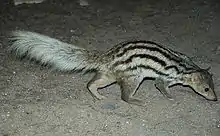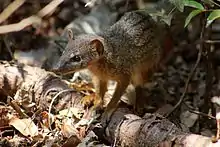Eupleridae
Eupleridae is a family of carnivorans endemic to Madagascar and comprising 10 known living species in seven genera, commonly known as euplerids, Malagasy mongooses or Malagasy carnivorans. The best known species is the fossa (Cryptoprocta ferox), in the subfamily Euplerinae. All species of Euplerinae were formerly classified as viverrids, while all species in the subfamily Galidiinae were classified as herpestids.
| Euplerids[1] | |
|---|---|
 | |
| Scientific classification | |
| Kingdom: | Animalia |
| Phylum: | Chordata |
| Class: | Mammalia |
| Order: | Carnivora |
| Suborder: | Feliformia |
| Family: | Eupleridae Chenu, 1850 |
| Genera | |
| |
 | |
| Eupleridae subfamily ranges | |
| Synonyms | |
| |
Recent molecular studies indicate that the 10 living species of Madagascar carnivorans evolved from one ancestor that is thought to have rafted over from mainland Africa 18–24 million years ago. This makes Malagasy carnivorans a clade. They are closely allied with the true herpestid mongooses, their closest living relatives.[2] The fossa and the Malagasy civet (Fossa fossana) are each evolutionarily quite distinct from each other and from the rest of the clade.
All Eupleridae are considered threatened species due to habitat destruction, as well as predation and competition from non-native species.[3]
Taxonomy and phylogeny
Historically, the relationships of the Madagascar carnivorans have been contentious, but molecular evidence suggests that they form a single clade, now recognized as the family Eupleridae.[4][5][6] The hyena family, Hyaenidae, is a sister taxon of the euplerid and herpestid clade, and when grouped together with the viverrids and felids, as well as some smaller groups, forms the feliform (cat-like carnivores) clade.[7][8]
The evolutionary divergence between the herpestids and the euplerids dates back to the Oligocene.[8] At that time, feliforms shared many similarities, particularly between the cats and the viverrids. Palaeoprionodon (within the superfamily Aeluroidea), found in Europe and Asia from the late Eocene or early Oligocene, looked similar to the modern fossa, while Proailurus, an extinct form of cat, exhibited many viverrid-like characteristics.[9] Despite these similarities in the fossil record, the modern Malagasy carnivores are distinctly different, with the Euplerinae and Galidiinae subfamilies bearing similarities with civets and mongooses, respectively.[7] Species in Euplerinae (including the fossa, falanouc, and Malagasy civet) have auditory regions similar to those of viverrids, while those in Galidiinae have auditory regions similar to those of herpestids. Based on this trait, Robert M. Hunt Jr. proposed in 1996 that Madagascar was colonized twice, once by viverrids and once by herpestids. However, the genetic studies by Yoder and colleagues in 2003 suggested that a single colonization event occurred by a primitive herpestid ancestor, which was quickly followed by adaptive radiation. The common ancestor arrived from Africa, probably by rafting, during the late Oligocene or early Miocene (24–18 Mya),[7][8] though Philippe Gaubert and Veron estimated a divergence date of 19.4 Mya (16.5–22.7 Mya).[8][10]
Classification
| Subfamily | Image | Genus | Species |
|---|---|---|---|
| Euplerinae |  |
Cryptoprocta (Bennett, 1833) |
|
 |
Eupleres (Doyère, 1835) |
| |
.jpg.webp) |
Fossa (Gray, 1864) |
| |
| Galidiinae | .jpg.webp) |
Galidia (I. Geoffroy Saint-Hilaire, 1837) |
|
 |
Galidictis (I. Geoffroy Saint-Hilaire, 1839) |
| |
 |
Mungotictis (Pocock, 1915) |
| |
 |
Salanoia (Gray, 1864) |
|
Phylogenetic tree
The phylogenetic relationships of Malagasy carnivorans (Eupleridae) are shown in the following cladogram:[4]
| Eupleridae |
| ||||||||||||||||||||||||||||||||||||||||||||||||||||||||||||
See also
References
- Wozencraft, W.C. (2005). "Order Carnivora". In Wilson, D.E.; Reeder, D.M (eds.). Mammal Species of the World: A Taxonomic and Geographic Reference (3rd ed.). Johns Hopkins University Press. pp. 532–628. ISBN 978-0-8018-8221-0. OCLC 62265494.
- Flynn, J; Finarelli, J. A.; Zehr, S; Hsu, J; Nedbal, M. A. (April 2005). "Molecular phylogeny of the carnivora (mammalia): assessing the impact of increased sampling on resolving enigmatic relationships". Syst. Biol. 54 (2): 317–337. doi:10.1080/10635150590923326. PMID 16012099.
- "Eupleridae". Animal Diversity. University of Michigan.
- Yoder, A.D.; Burns, M.M.; Zehr, S.; Delefosse, T.; Veron, G.; Goodman, S.M.; Flynn, J.J. (2003). "Single origin of Malagasy Carnivora from an African ancestor" (PDF). Nature. 421 (6924): 734–737. doi:10.1038/nature01303. PMID 12610623. S2CID 4404379. Retrieved 19 May 2010.
- Wozencraft, W.C. (2005). "Order Carnivora". In Wilson, D.E.; Reeder, D.M. (eds.). Mammal Species of the World (3rd ed.). Johns Hopkins University Press. pp. 559–561. ISBN 978-0-8018-8221-0.
- Gaubert, Philippe; Wozencraft, W Chris; Cordeiro-Estrela, Pedro; Veron, Geraldine (December 2005). "Mosaics of Convergences and Noise in Morphological Phylogenies: What's in a Viverrid-Like Carnivoran?". Systematic Biology. 54 (6): 865–894. doi:10.1080/10635150500232769. PMID 16282167. Retrieved 10 March 2020.
- Yoder, A.D.; Flynn, J.J. (2003). "Origin of Malagasy Carnivora". In Goodman, S.M.; Benstead, J.P. (eds.). The Natural History of Madagascar. University of Chicago Press. pp. 1253–1256. ISBN 978-0-226-30306-2.
- Barycka, E. (2007). "Evolution and systematics of the feliform Carnivora". Mammalian Biology. 72 (5): 257–282. doi:10.1016/j.mambio.2006.10.011.
- Köhncke, M.; Leonhardt, K. (1986). "Cryptoprocta ferox" (PDF). Mammalian Species (254): 1–5. doi:10.2307/3503919. JSTOR 3503919. Archived from the original (PDF) on 2010-06-21. Retrieved 19 May 2010.
- Gaubert, P.; Veron, G. (2003). "Exhaustive sample set among Viverridae reveals the sister-group of felids: the linsangs as a case of extreme morphological convergence within Feliformia". Proceedings of the Royal Society B. 270 (1532): 2523–2530. doi:10.1098/rspb.2003.2521. PMC 1691530. PMID 14667345.
External links
| Wikispecies has information related to Eupleridae. |
| Wikimedia Commons has media related to Eupleridae. |